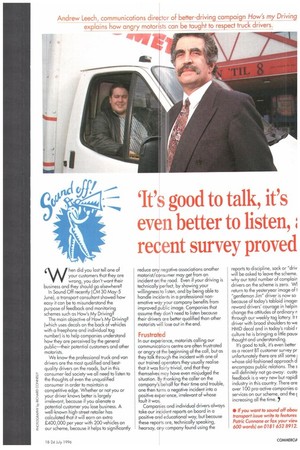Vs good to talk, it's
Page 51

If you've noticed an error in this article please click here to report it so we can fix it.
even better to listen, recent survey proved
6 hen did you last tell one of
your customers that they are wrong, you don't want their business and they should go elsewhere? In Sound Off recently (CM 30 May-5 June), a transport consultant showed how easy it can be to misunderstand the purpose of feedback and monitoring schemes such as How's My Driving? The main objective of How's My Driving? (which uses decals on the back of vehicles with a freephone and individual tag number) is to help companies understand how they are perceived by the general public—their potential customers and other motorists.
We know the professional truck and van drivers are the most qualified and bestquality drivers on the roads, but in this consumer-led society we all need to listen to the thoughts of even the unqualified consumer in order to maintain a competitive edge. Whether or not you or your driver knows better is largely irrelevant, because if you alienate a potential customer you lose business. A well-known high-street retailer has calculated that it will earn an extra £400,000 per year with 200 vehicles on our scheme, because it helps to significantly reduce any negative associations another motorist/consumer may get from an incident on the road. Even if your driving is technically perfect, by showing your willingness to listen, and by being able to handle incidents in a professional nonemotive way your company benefits from improved public image. Companies that assume they don't need to listen because their drivers are better qualified than other motorists will lose out in the end.
Frustrated
In our experience, motorists calling our communications centre are often frustrated or angry at the beginning of the call, but as they talk through the incident with one of our trained operators they usually realise that it was fair y trivial, and that they themselves may have even misjudged the situation. By thanking the caller on the company's behalf for their time and trouble, one then turns a negative incident into a positive exper ence, irrelevant of whose fault it was.
Companies and individual drivers always take our incident reports on board in a positive and educational way, but because these reports are, technically speaking, hearsay, any company found using the reports to discipline, sack or "driv will be asked to leave the scheme. why our total number of complain drivers on the scheme is zero. WI return to the yesteryear image oft "gentleman Jim" driver is now so because of today's tabloid image! reward drivers' courage in helpin change the attitudes of ordinary r through our weekly tag lottery. It t driver with broad shoulders to we HMD decal and in today's rabid r culture he is bringing a little pausi thought and understanding. It's good to talk, it's even better as a recent BT customer survey pr unfortunately there are still some] whose old-fashioned approach d encompass public relations The s will definitely not go away: custo feedback is a very new but rapid) industry in this country. There are over 100 pro-active companies a services on our scheme, and the < increasing all the time.
• if you want to sound off abou transport issue write to features Patric Cunnane or fax your viers 600 words) on 0181 652 8912.












































































































